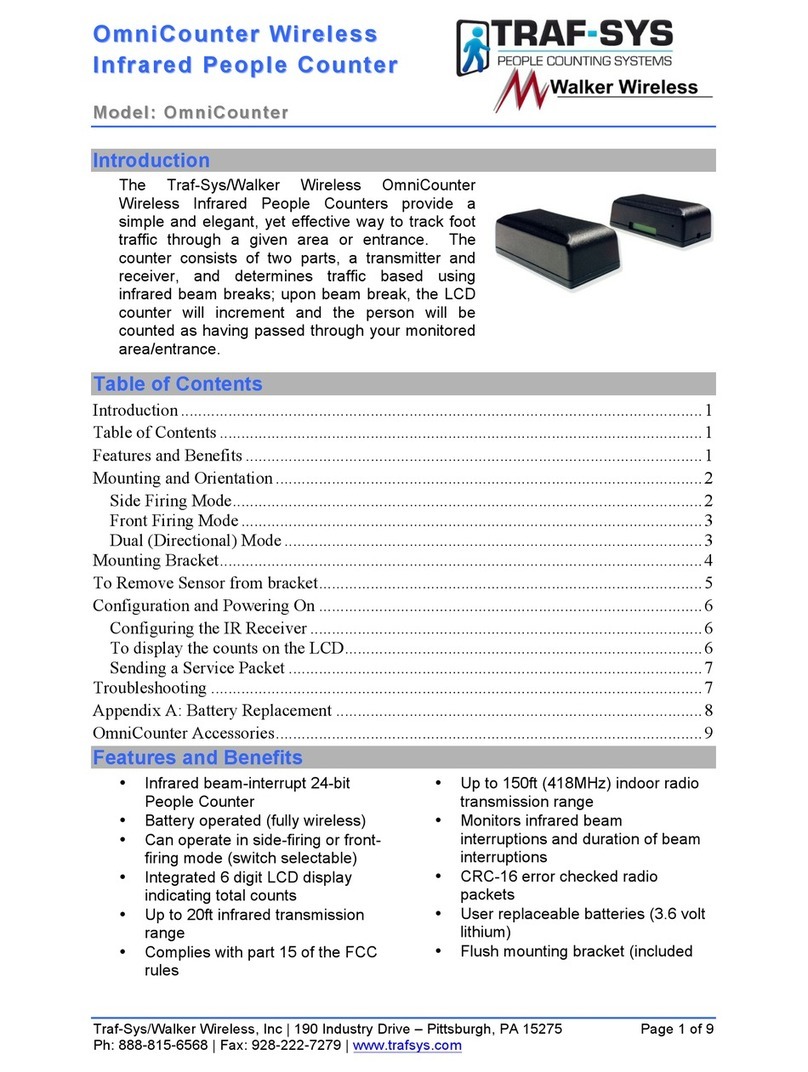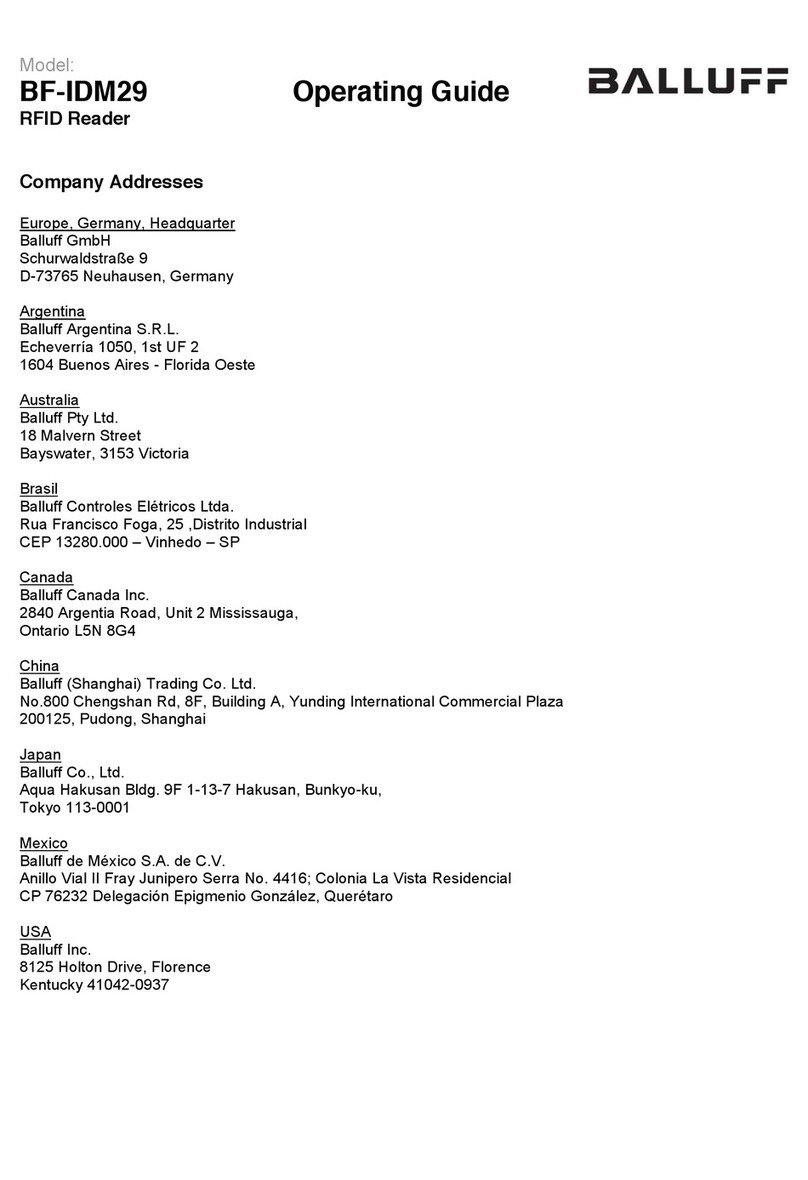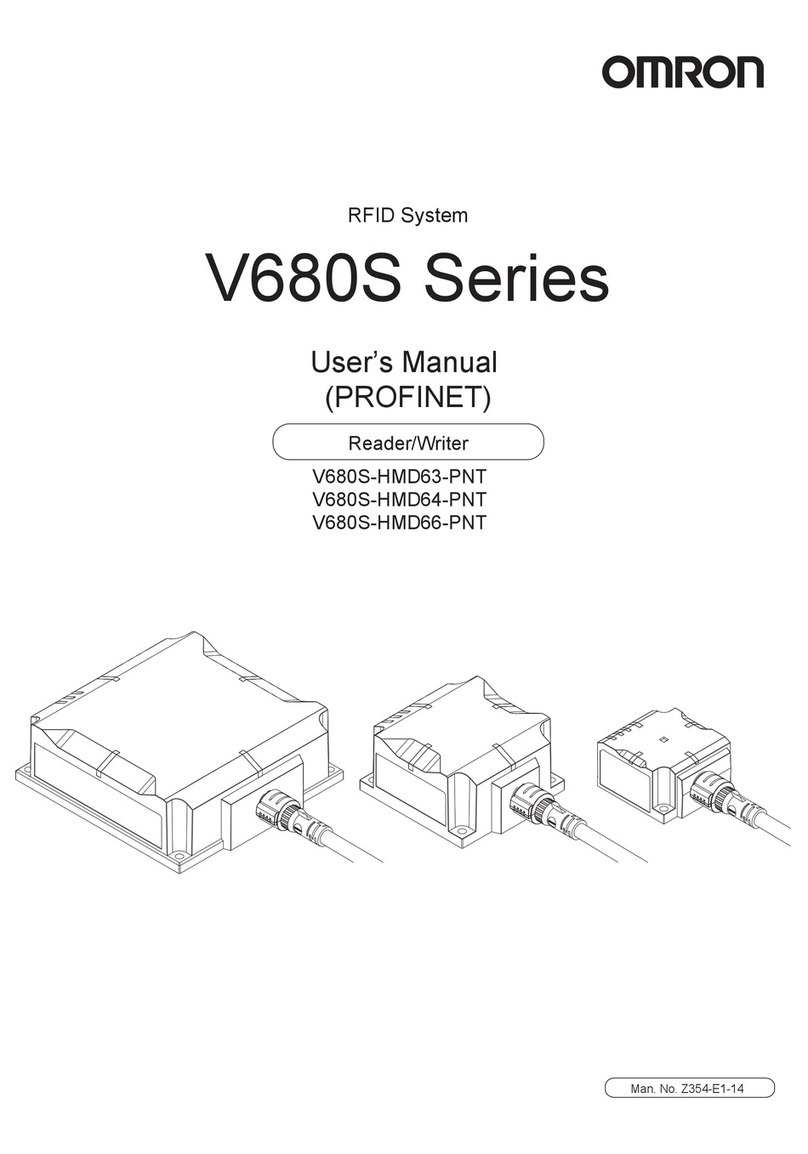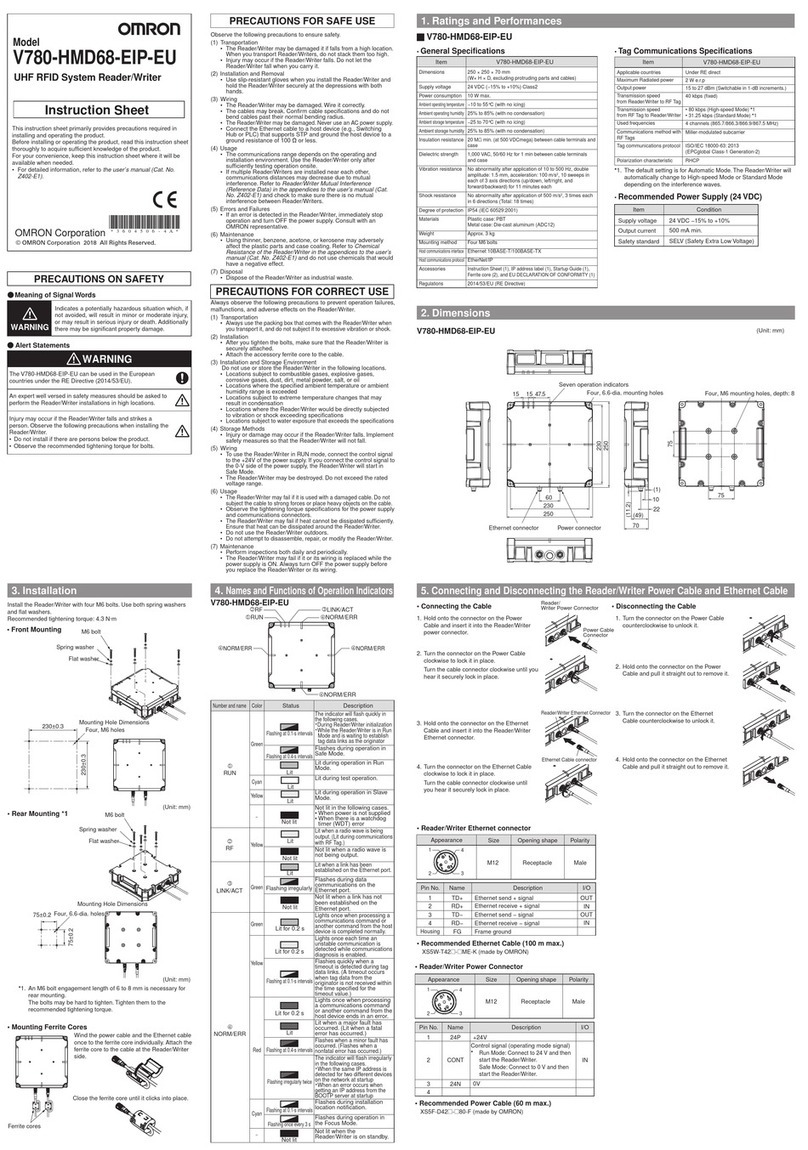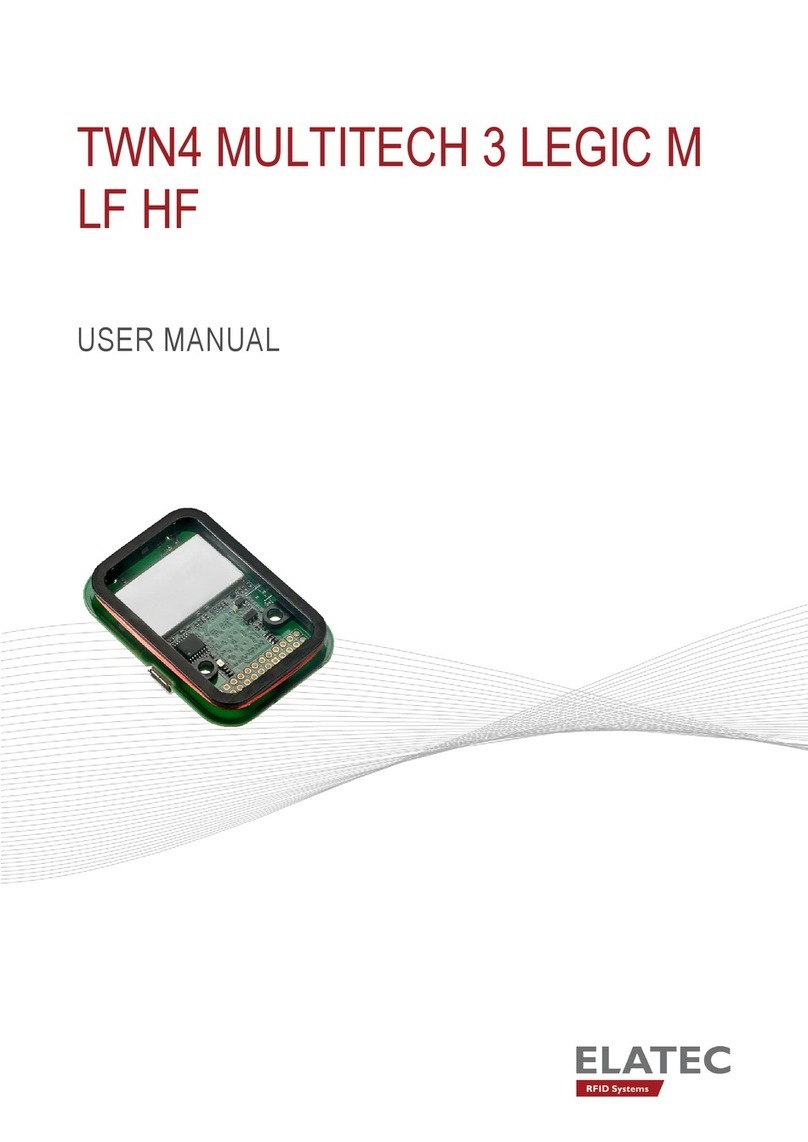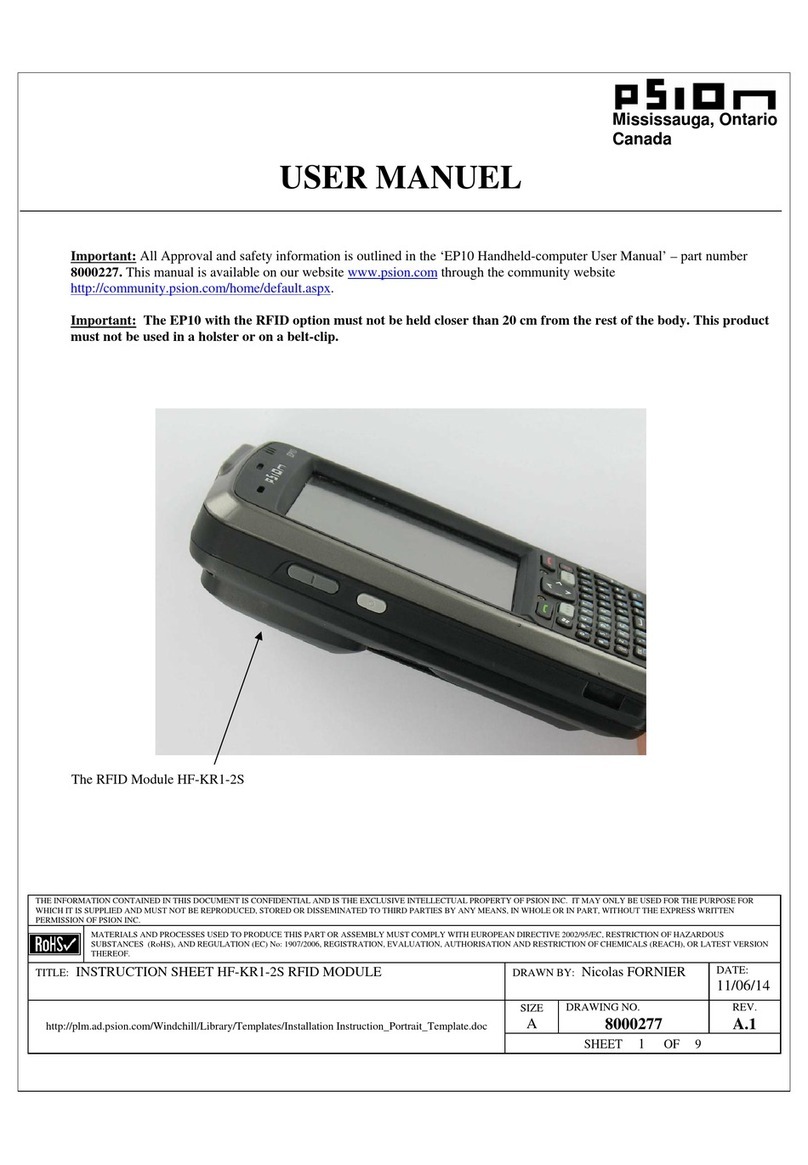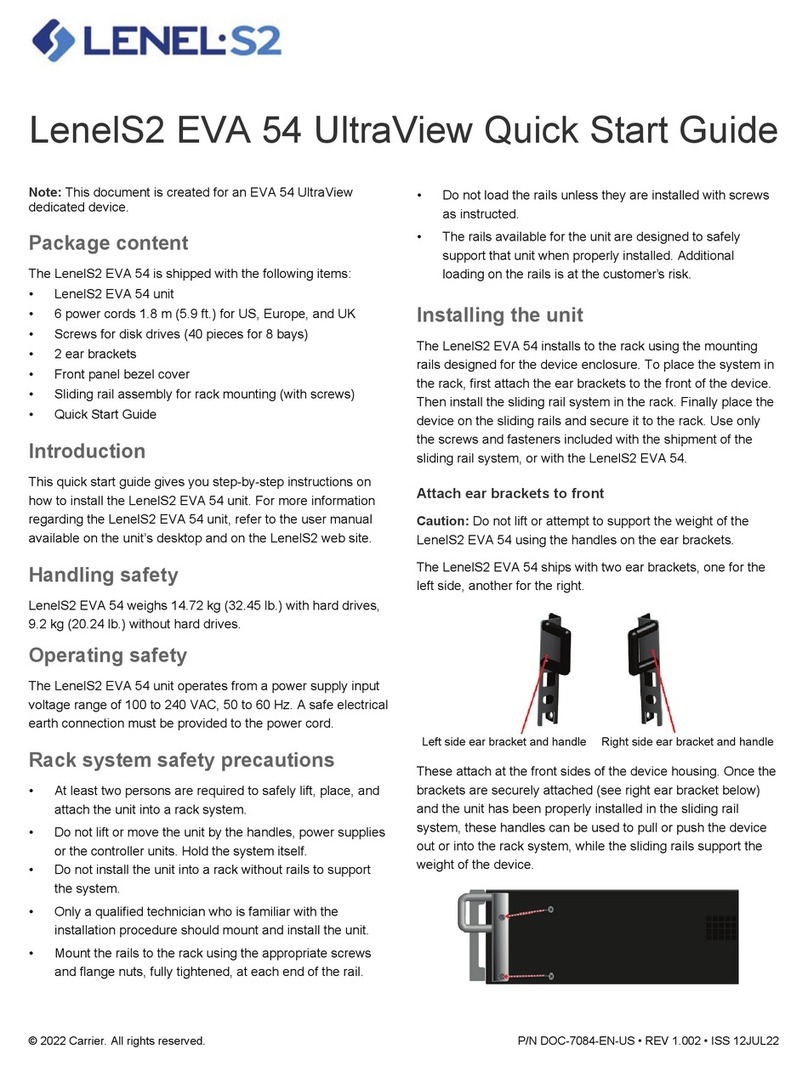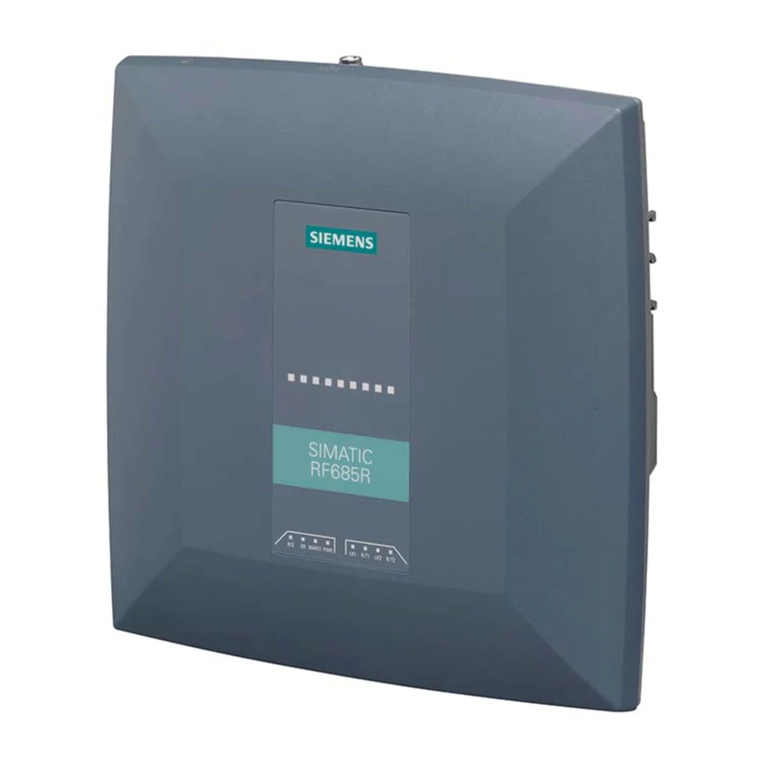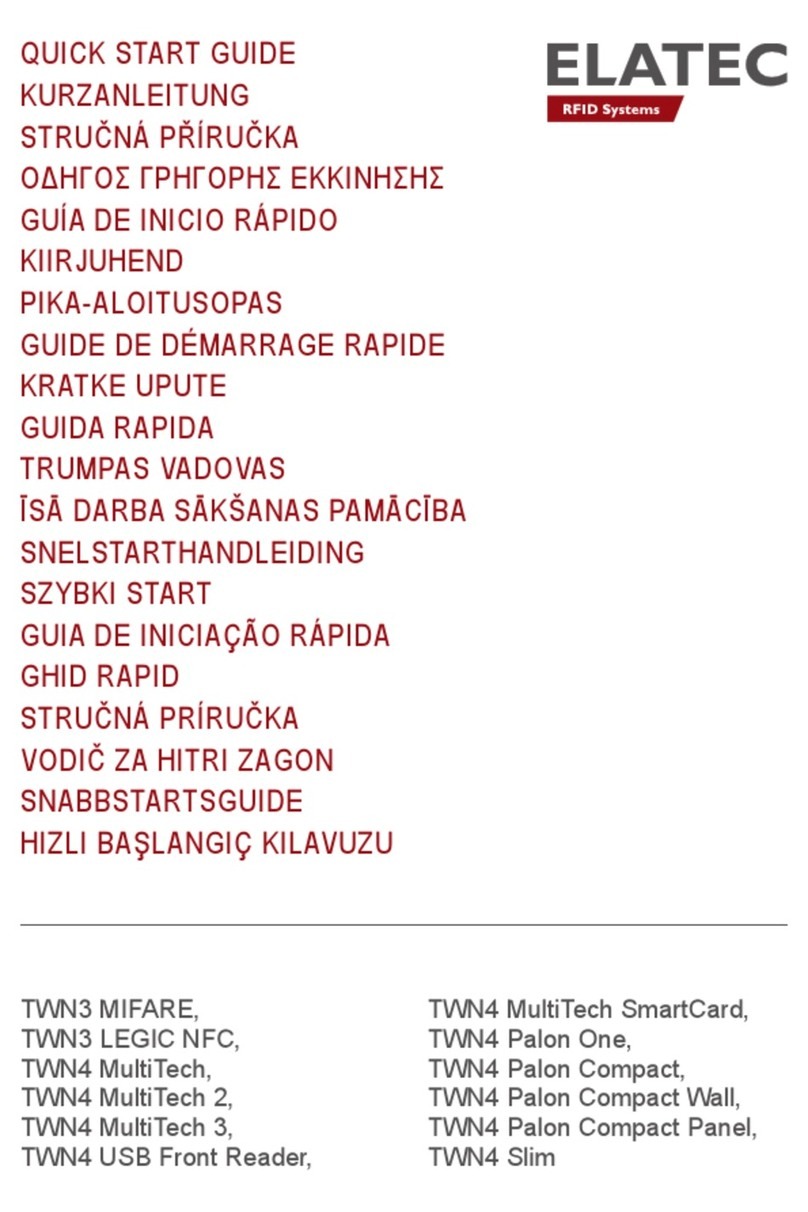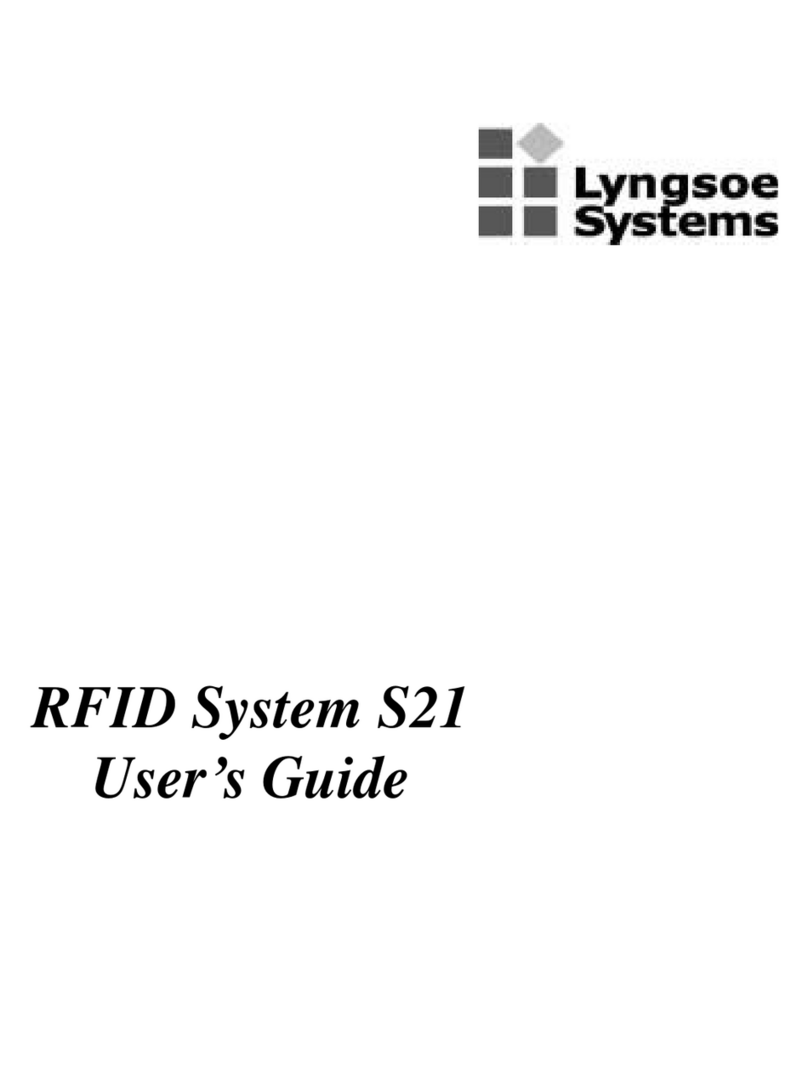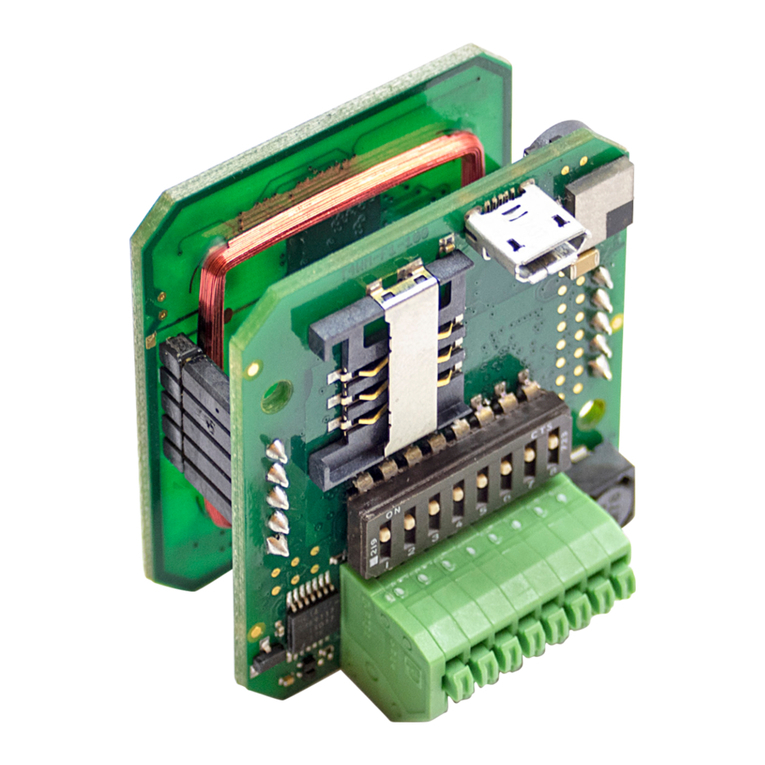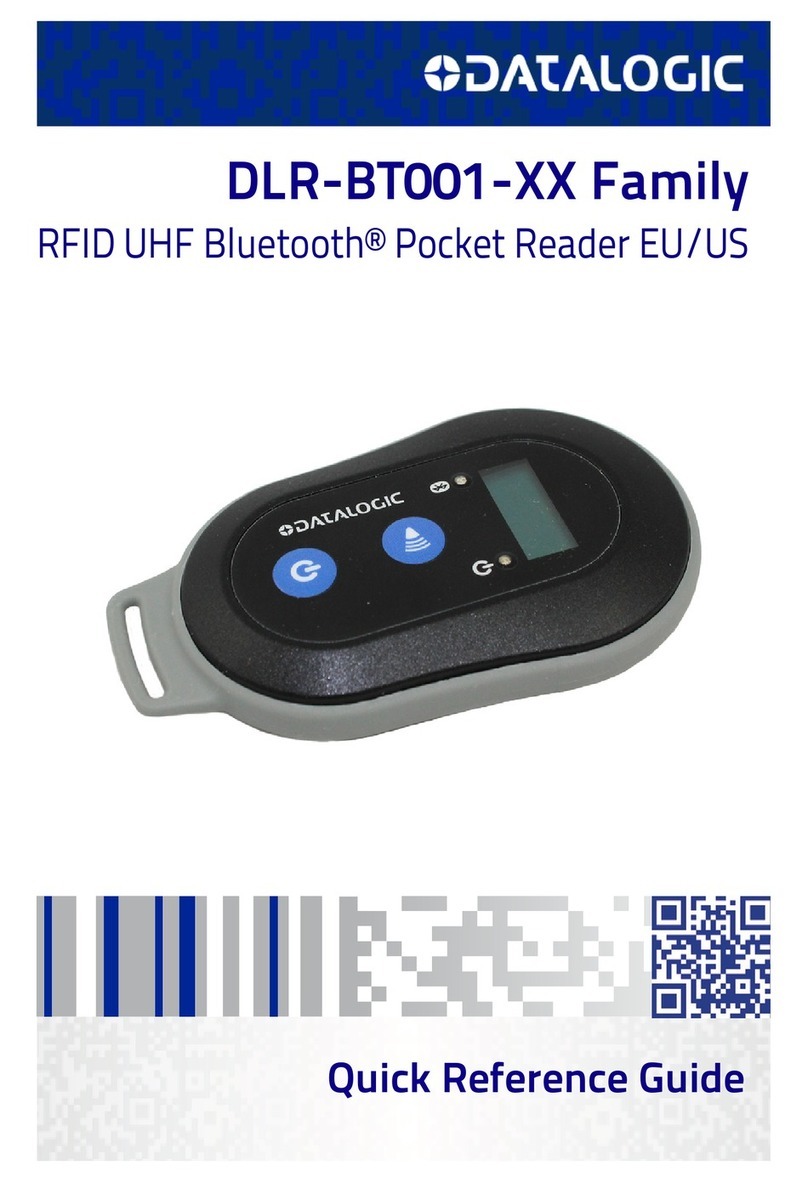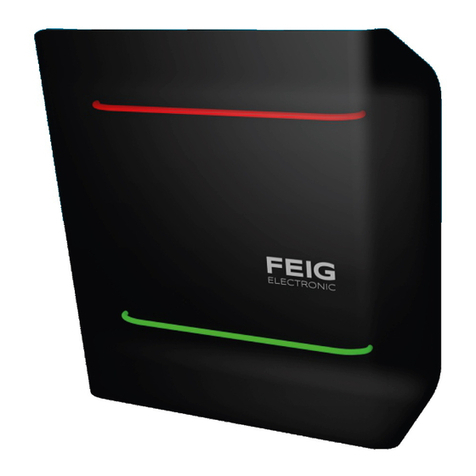Rockwell Automation Allen-Bradley 58UHF User manual

User Manual Original Instructions
58UHF RFID Systems
Bulletin Number 58UHF

2Rockwell Automation Publication 58UHF-UM001A-EN-P - January 2023
58UHF RFID Systems User Manual
Important User Information
Read this document and the documents listed in the additional resources section about installation, configuration, and operation of this equipment before
you install, configure, operate, or maintain this product. Users are required to familiarize themselves with installation and wiring instructions in addition to
requirements of all applicable codes, laws, and standards.
Activities including installation, adjustments, putting into service, use, assembly, disassembly, and maintenance are required to be carried out by suitably
trained personnel in accordance with applicable code of practice.
If this equipment is used in a manner not specified by the manufacturer, the protection provided by the equipment may be impaired.
In no event will Rockwell Automation, Inc. be responsible or liable for indirect or consequential damages resulting from the use or application of this
equipment.
The examples and diagrams in this manual are included solely for illustrative purposes. Because of the many variables and requirements associated with
any particular installation, Rockwell Automation, Inc. cannot assume responsibility or liability for actual use based on the examples and diagrams.
No patent liability is assumed by Rockwell Automation, Inc. with respect to use of information, circuits, equipment, or software described in this manual.
Reproduction of the contents of this manual, in whole or in part, without written permission of Rockwell Automation, Inc., is prohibited.
Throughout this manual, when necessary, we use notes to make you aware of safety considerations.
These labels may also be on or inside the equipment to provide specific precautions.
The following icon may appear in the text of this document.
WARNING: Identifies information about practices or circumstances that can cause an explosion in a hazardous environment,
which may lead to personal injury or death, property damage, or economic loss.
ATTENTION: Identifies information about practices or circumstances that can lead to personal injury or death, property
damage, or economic loss. Attentions help you identify a hazard, avoid a hazard, and recognize the consequence.
IMPORTANT Identifies information that is critical for successful application and understanding of the product.
SHOCK HAZARD: Labels may be on or inside the equipment, for example, a drive or motor, to alert people that dangerous
voltage may be present.
BURN HAZARD: Labels may be on or inside the equipment, for example, a drive or motor, to alert people that surfaces may
reach dangerous temperatures.
ARC FLASH HAZARD: Labels may be on or inside the equipment, for example, a motor control center, to alert people to
potential Arc Flash. Arc Flash will cause severe injury or death. Wear proper Personal Protective Equipment (PPE). Follow ALL
Regulatory requirements for safe work practices and for Personal Protective Equipment (PPE).
Identifies information that is useful and can help to make a process easier to do or easier to understand.

Rockwell Automation Publication 58UHF-UM001A-EN-P - January 2023 3
Table of Contents
Purpose of this Manual. . . . . . . . . . . . . . . . . . . . . . . . . . . . . . . . . . . . . . . . . . . . . . . . . . . . . . 5
Who Should Use this Manual . . . . . . . . . . . . . . . . . . . . . . . . . . . . . . . . . . . . . . . . . . . . . . . . . 5
Abbreviations . . . . . . . . . . . . . . . . . . . . . . . . . . . . . . . . . . . . . . . . . . . . . . . . . . . . . . . . . . . . . 5
Additional Resources . . . . . . . . . . . . . . . . . . . . . . . . . . . . . . . . . . . . . . . . . . . . . . . . . . . . . . . 6
Chapter 1
Introduction RFID Definition . . . . . . . . . . . . . . . . . . . . . . . . . . . . . . . . . . . . . . . . . . . . . . . . . . . . . . . . . . . . 7
International Standard Compliance . . . . . . . . . . . . . . . . . . . . . . . . . . . . . . . . . . . . . . . . . . . 7
FCC Information (58UHF-TR-100-SR15US and 58UHF-TR-200-LR50US Models). . . . 7
ISED Information. . . . . . . . . . . . . . . . . . . . . . . . . . . . . . . . . . . . . . . . . . . . . . . . . . . . . . . 8
Declaration of Conformity . . . . . . . . . . . . . . . . . . . . . . . . . . . . . . . . . . . . . . . . . . . . . . . . . . . 9
CE Conformity . . . . . . . . . . . . . . . . . . . . . . . . . . . . . . . . . . . . . . . . . . . . . . . . . . . . . . . . . 9
UKCA Conformity. . . . . . . . . . . . . . . . . . . . . . . . . . . . . . . . . . . . . . . . . . . . . . . . . . . . . . . 9
System Setup . . . . . . . . . . . . . . . . . . . . . . . . . . . . . . . . . . . . . . . . . . . . . . . . . . . . . . . . . . . . . 9
Chapter 2
RFID Components Transceivers . . . . . . . . . . . . . . . . . . . . . . . . . . . . . . . . . . . . . . . . . . . . . . . . . . . . . . . . . . . . . 11
Status Indicators Functionality. . . . . . . . . . . . . . . . . . . . . . . . . . . . . . . . . . . . . . . . . . 11
Product Selection . . . . . . . . . . . . . . . . . . . . . . . . . . . . . . . . . . . . . . . . . . . . . . . . . . . . . . . . . 12
Main Components . . . . . . . . . . . . . . . . . . . . . . . . . . . . . . . . . . . . . . . . . . . . . . . . . . . . . 12
Accessories . . . . . . . . . . . . . . . . . . . . . . . . . . . . . . . . . . . . . . . . . . . . . . . . . . . . . . . . . . 12
Chapter 3
Electrical Installation Cable Overview . . . . . . . . . . . . . . . . . . . . . . . . . . . . . . . . . . . . . . . . . . . . . . . . . . . . . . . . . . . 13
Connections. . . . . . . . . . . . . . . . . . . . . . . . . . . . . . . . . . . . . . . . . . . . . . . . . . . . . . . . . . . . . . 13
Power I/O Connection (on Transceiver) . . . . . . . . . . . . . . . . . . . . . . . . . . . . . . . . . . . 13
EtherNet/IP Connection (on Transceiver) . . . . . . . . . . . . . . . . . . . . . . . . . . . . . . . . . 13
Chapter 4
EtherNet/IP Addressing Star Topology . . . . . . . . . . . . . . . . . . . . . . . . . . . . . . . . . . . . . . . . . . . . . . . . . . . . . . . . . . . . 15
Linear Topology . . . . . . . . . . . . . . . . . . . . . . . . . . . . . . . . . . . . . . . . . . . . . . . . . . . . . . . . . . 16
Device Level Ring (DLR) Topology. . . . . . . . . . . . . . . . . . . . . . . . . . . . . . . . . . . . . . . . . . . . 16
Set the Network Address . . . . . . . . . . . . . . . . . . . . . . . . . . . . . . . . . . . . . . . . . . . . . . . . . . . 17
Set IP Address . . . . . . . . . . . . . . . . . . . . . . . . . . . . . . . . . . . . . . . . . . . . . . . . . . . . . . . . . . . . 18
Chapter 5
Mechanical Installation Mount the Transceiver . . . . . . . . . . . . . . . . . . . . . . . . . . . . . . . . . . . . . . . . . . . . . . . . . . . . . 21
Spacing . . . . . . . . . . . . . . . . . . . . . . . . . . . . . . . . . . . . . . . . . . . . . . . . . . . . . . . . . . . . . . . . . 21
Transceiver Field Maps . . . . . . . . . . . . . . . . . . . . . . . . . . . . . . . . . . . . . . . . . . . . . . . . . . . . 21
Approximate Dimensions. . . . . . . . . . . . . . . . . . . . . . . . . . . . . . . . . . . . . . . . . . . . . . . . . . . 21
Chapter 6
Add 58UHF Module to
RSLogix5000
Procedure . . . . . . . . . . . . . . . . . . . . . . . . . . . . . . . . . . . . . . . . . . . . . . . . . . . . . . . . . . . . . . . 23
General Tab . . . . . . . . . . . . . . . . . . . . . . . . . . . . . . . . . . . . . . . . . . . . . . . . . . . . . . . . . . . . . . 24
IP Address . . . . . . . . . . . . . . . . . . . . . . . . . . . . . . . . . . . . . . . . . . . . . . . . . . . . . . . . . . . 25

4Rockwell Automation Publication 58UHF-UM001A-EN-P - January 2023
Table of Contents
Module Definition . . . . . . . . . . . . . . . . . . . . . . . . . . . . . . . . . . . . . . . . . . . . . . . . . . . . . . . . . 25
Connection Tab. . . . . . . . . . . . . . . . . . . . . . . . . . . . . . . . . . . . . . . . . . . . . . . . . . . . . . . . . . . 26
Module Info Tab. . . . . . . . . . . . . . . . . . . . . . . . . . . . . . . . . . . . . . . . . . . . . . . . . . . . . . . . . . . 26
Antenna Tab . . . . . . . . . . . . . . . . . . . . . . . . . . . . . . . . . . . . . . . . . . . . . . . . . . . . . . . . . . . . . 27
Points Tab . . . . . . . . . . . . . . . . . . . . . . . . . . . . . . . . . . . . . . . . . . . . . . . . . . . . . . . . . . . . . . . 27
Filter Tab . . . . . . . . . . . . . . . . . . . . . . . . . . . . . . . . . . . . . . . . . . . . . . . . . . . . . . . . . . . . . . . . 28
Good Read Condition Tab. . . . . . . . . . . . . . . . . . . . . . . . . . . . . . . . . . . . . . . . . . . . . . . . . . . 28
Internet Protocol Tab . . . . . . . . . . . . . . . . . . . . . . . . . . . . . . . . . . . . . . . . . . . . . . . . . . . . . . 28
Port Configuration Tab. . . . . . . . . . . . . . . . . . . . . . . . . . . . . . . . . . . . . . . . . . . . . . . . . . . . . 29
Network Tab . . . . . . . . . . . . . . . . . . . . . . . . . . . . . . . . . . . . . . . . . . . . . . . . . . . . . . . . . . . . . 30
Chapter 7
RSLogix 5000 Controller Tags Configuration Image Table and Tags . . . . . . . . . . . . . . . . . . . . . . . . . . . . . . . . . . . . . . . . . 32
Input Image Table and Tags . . . . . . . . . . . . . . . . . . . . . . . . . . . . . . . . . . . . . . . . . . . . . . . . 34
Allowable Commands . . . . . . . . . . . . . . . . . . . . . . . . . . . . . . . . . . . . . . . . . . . . . . . . . . . . . . 38
Output Image Table and Tags . . . . . . . . . . . . . . . . . . . . . . . . . . . . . . . . . . . . . . . . . . . . . . . 39
Chapter 8
RSLogix 5000 Code Examples Continuous Inventory. . . . . . . . . . . . . . . . . . . . . . . . . . . . . . . . . . . . . . . . . . . . . . . . . . . . . . 43
Queued Command. . . . . . . . . . . . . . . . . . . . . . . . . . . . . . . . . . . . . . . . . . . . . . . . . . . . . . . . . 47
Get TID . . . . . . . . . . . . . . . . . . . . . . . . . . . . . . . . . . . . . . . . . . . . . . . . . . . . . . . . . . . . . . . . . . 48
Appendix A
Specifications General. . . . . . . . . . . . . . . . . . . . . . . . . . . . . . . . . . . . . . . . . . . . . . . . . . . . . . . . . . . . . . . . . . 51
Connections. . . . . . . . . . . . . . . . . . . . . . . . . . . . . . . . . . . . . . . . . . . . . . . . . . . . . . . . . . . . . . 51
Appendix B
Add-on Profile Install . . . . . . . . . . . . . . . . . . . . . . . . . . . . . . . . . . . . . . . . . . . . . . . . . . . . . . . . . . . . . . . . . . . 53
Appendix C
Troubleshooting RF Tags . . . . . . . . . . . . . . . . . . . . . . . . . . . . . . . . . . . . . . . . . . . . . . . . . . . . . . . . . . . . . . . . . 55
Index . . . . . . . . . . . . . . . . . . . . . . . . . . . . . . . . . . . . . . . . . . . . . . . . . . . .57

Rockwell Automation Publication 58UHF-UM001A-EN-P - January 2023 5
Preface
Purpose of this Manual This user manual assumes you are familiar with RSLogix™ software. This manual provides an
example of steps to configure and make functional a 58UHF RFID system. See the appropriate
user manuals for other details. Use this manual to accomplish the following:
• Learn how to install and wire an example RFID system.
• Install and configure the module in an RSLogix 5000® program.
• Built a simple program to receive and transmit data to an RFID tag.
Who Should Use this Manual Use this manual if you are responsible for design, installation, programming, or
troubleshooting of control systems that use Bulletin 58UHF RFID products.
You must have a basic understanding of electrical circuitry and familiarity with relay logic. If
you do not, obtain the proper training before using this product.
Abbreviations Abbreviation Definition Abbreviation Definition
AFI Application Family Identifier ISO International Organization for
Standardization
AOI Add-On Instruction
AOP Add-on Profile JTC Joint Technical Committee
CRD Customer Requirement Document MAC address Media Access Control (Ethernet)
address
DFSID Data Storage Format Identifier
DHCP Dynamic Host Configuration Protocol MACID Media Access Control Identification
DLR Device Level Ring QD Quick Disconnect
DNS Domain Name Server RFID Radio Frequency Identification
Device
DoS Disk Operating System SB Subcommittee
EAS Electronic Article Surveillance SINT Signed, single-byte integer
FE Functional Earth UHF Ultra High Frequency
INT Signed, two-byte integer
UII/EPC Unique Item Identifier/Electric
Product Code
IEC International Electrotechnical
Commission

6Rockwell Automation Publication 58UHF-UM001A-EN-P - January 2023
Preface
Additional Resources These documents contain additional information concerning related products from Rockwell
Automation.
You can view or download publications at rok.auto/literature.
Resource Description
58UHF RFID Short-range Transceiver Installation
Instructions, publication 58UHF-IN001
Provides information that is required to install short-
range transceivers for both EU/UK and US/North
America models.
58UHF RFID Long-range Transceiver Installation
Instructions, publication 58UHF-IN002
Provides information that is required to install long-
range transceivers for both EU/UK and US/North
America models.
CIP Security with Rockwell Automation Products,
publication SECURE-AT001
Describes how to implement the Common Industrial
Protocol (CIP™) Security standard in your industrial
automation control system (IACS). (1)
(1) When using CIP Security™, only use version 6.2 for FactoryTalk® Policy Manager.
EtherNet/IP Network Devices User Manual, publication
ENET-UM006
This manual describes how to use EtherNet/IP™
communication modules in Logix 5000™ control
systems.
Allen-Bradley Industrial Automation Glossary, AG-7.1 A glossary of industrial automation terms and
abbreviations.
EtherNet/IP Device Level Ring Application Technique,
publication ENET-AT007
This publication describes DLR network operation,
topologies, configuration considerations, and
diagnostic methods.
Industrial Automation Wiring and Grounding Guidelines,
publication 1770-4.1 Provides general guidelines for installing a Rockwell
Automation® industrial system.
Product Certifications website, rok.auto/certifications Provides declarations of conformity, certificates, and
other certification details.

Rockwell Automation Publication 58UHF-UM001A-EN-P - January 2023 7
Chapter 1
Introduction
RFID Definition RFID (radio frequency identification) is a method to communicate information from one point
to another point by the use of electromagnetic waves (radio waves). RFID has unique
characteristics that make it attractive for use in industrial systems.
For example, you must load a shipping carton with various goods to meet the specific
purchase order of a customer. You can fill a tag with the specific items that the customer
wants and attach the tag to the carton. Then, as the carton moves to the filling stations, each
station places the required objects into the carton. If the tag does not require an item, the
station is skipped.
Each filling station has an RFID transceiver. The transceiver reads and writes to the tag. When
the tag approaches the RFID transceiver, the transceiver reads the contents of the tag. Based
on the information that is received, the packaging process adds items (or skips this step) and
then writes to the tag that one or more items were added. The carton moves to the next filling
station.
This scenario is a common use of RFID technology. The Bulletin 58UHF product line is unique
because of its conformance to the open international standards: ISO 18000-63 standard
Type C (EPCglobal Gen2).
International Standard
Compliance
Use the EPCglobal Gen2 (ISO 18000-63) standard. This standard is for transceivers and tags
that operate within the 860…960 MHz radio frequency range. Passive tags are tags that
receive their power from the transceivers signal to function. These tags respond by
backscattering this information to the transceiver. You can use different tag options from
multiple vendors as long as the tags follow the same standard that is previously listed.
The EPCglobal Gen2 (ISO 18000-63) standard specifies the requirements for the signaling layer
of communications between transceivers and tags. This standard also specifies requirements
for the operating procedures, for commands between transceiver and tag, and for air
interference.
FCC Information (58UHF-TR-100-SR15US and 58UHF-TR-200-LR50US
Models)
Each country has their specific frequency band requirements.
This device complies with Part 15 of the FCC Rules. Operation is subject to the following
conditions:
1. This device must not cause harmful interference, and
2. This device must accept any interference received, including interference that can
cause undesired operation.
Changes and modifications that Rockwell Automation does not explicitly approve can void your
authority to operate this equipment under the rules of the Federal Communications
Commission.

8Rockwell Automation Publication 58UHF-UM001A-EN-P - January 2023
Chapter 1 Introduction
ISED Information
Short-range Model (58UHF-TR-100-SR15US)
This device complies with the Innovation, Science, and Economic Development license-
exempt RSS Industry Canada license-exempt RSS standards. Operation is subject to the
following two conditions: (1) this device may not cause interference; and (2) this device must
accept any interference, including interference that may cause undesired operation of the
device.
Le présent appareil est conforme aux CNR d’Innovation, Sciences et Développement
économique Canada applicables aux appareils radio exempts de licence. L'exploitation est
autorisée aux deux conditions suivantes: (1) l'appareil ne doit pas produire de brouillage, et (2)
l'utilisateur de l'appareil doit accepter tout brouillage radioélectrique subi, même si le
brouillage est susceptible d'en compromettre le fonctionnement.
Long-range Model (58UHF-200-LR50US)
This device complies with Innovation, Science, and Economic Development Canada license-
exempt RSS standards. Operation is subject to the following two conditions: (1) this device may
not cause interference; and (2) this device must accept any interference, including
interference that may cause undesired operation of the device.
Le présent appareil est conforme aux CNR d’Innovation, Sciences et Développement
économique Canada applicables aux appareils radio exempts de licence. L'exploitation est
autorisée aux deux conditions suivantes: (1) l'appareil ne doit pas produire de brouillage, et (2)
l'utilisateur de l'appareil doit accepter tout brouillage radioélectrique subi, même si le
brouillage est susceptible d'en compromettre le fonctionnement.
IMPORTANT This equipment complies with ISED radiation exposure limits for an
uncontrolled environment and meets RSS 102 of the ISED radio
frequency (RF) Exposure rules. When you install and operate this
equipment, keep a minimum of 35 cm (13.78 in.) between the radiator
and a person’s body.
Cet équipement est conforme aux limites d’exposition aux
rayonnements énoncées pour un environnement non-contrôlé et
respecte les règles d’exposition aux fréquences radioélectriques (RF)
CNR 102 de l’ISDE. Cet équipement doit être installé et utilisé en gardant
une distance de 35 cm (13.78 in.) ou plus entre le radiateur et le corps
humain.
IMPORTANT This equipment complies with ISED radiation exposure limits for an
uncontrolled environment and meets RSS-102 of the ISED radio
frequency (RF) Exposure rules. When you install and operate this
equipment, keep a minimum of 90 cm (35.4 in.) between the radiator
and a person’s body.
Cet équipement est conforme aux limites d’exposition aux
rayonnements énoncées pour un environnement non-contrôlé et
respecte les règles d’exposition aux fréquences radioélectriques (RF)
CNR-102 de l’ISDE. Cet équipement doit être installé et utilisé en gardant
une distance de 90 cm (35.4 in.) ou plus entre le radiateur et le corps
humain.

Rockwell Automation Publication 58UHF-UM001A-EN-P - January 2023 9
Chapter 1 Introduction
Declaration of Conformity CE Conformity
Rockwell Automation, Inc. declares that 58UHF-TR-100-LR15EU and 58UHF-TR-100-SR15EU are
in compliance with the 2014/53/EU Radio Equipment Directive and the 2011/65/EU RoHS
Directive.
For a comprehensive CE certificate visit: rok.auto/certifications.
UKCA Conformity
Rockwell Automation, Inc. declares that 58UHF-TR-100-LR15EU and 58UHF-TR-100-SR15EU are
in compliance with the Radio Equipment Regulations (2017 No. 1206) and the Restriction of the
Use of Certain Hazardous Substances in Electrical and Electronic Equipment Regulations (2012
No. 3032).
For a comprehensive UKCA certificate visit: rok.auto/certifications.
System Setup Figure 1 shows a simple RFID system. This user manual describes the setup, installation, and
programming that is required for this system to run.
Figure 1 - RFID System
Tags attach to objects that must be tracked. The tags hold important information about the
object. An RF transceiver reads and/or writes information to the tags when the tag moves
within the transmission envelope of the transceiver (dotted ellipse). The physical size of the
transceiver directly relates to the size of the transmission field. The larger the transceiver, the
longer and wider the antenna field.
The transceivers connect to a PLC through an Ethernet connection and have an external power
source.
2
3
4
5
1
P
W
R
1783-US05T
1756-L85E
ControlLogix®
Controller
1783-US05T
Ethernet Switch
58UHF Transceiver
58UHF Tag
Tracked
Object
Computer

10 Rockwell Automation Publication 58UHF-UM001A-EN-P - January 2023
Chapter 1 Introduction
Notes:

Rockwell Automation Publication 58UHF-UM001A-EN-P - January 2023 11
Chapter 2
RFID Components
Transceivers Status Indicators Functionality
Table 1 - Status Indicators (1)
(1) Status indicators are the same for short and long-range transceivers.
Name Description State Indicates
MOD Indicates status of
the transceivers
Off No power
Steady green Device operational
Flashing green Standby (device has not been configured)
Flashing red Major recoverable fault
Steady red Major nonrecoverable fault
Flashing green/red Self-test (power-up testing)
Link1/2 Indicates status of
Ethernet (E1/E2) port
Off No link
Steady green Link
Steady yellow Port disabled
Flashing green Port activity (data packets currently being exchanged)
Flashing yellow Collision
Steady red Major NIC fault
NET Indicates status of
the connections
Off No power or powered on with no IP address
Flashing green No connections (IP address, but no CIP™ connections are
established, and an exclusive owner connection has timed
out)
Steady green Connected
Flashing red Connection timeout
Steady red Duplicate IP
Flashing green/red Self-test (power-up testing)
R/W Indicates status of
the read/write
commands
Off No power
Steady green Powered but idle
Flashing green Transmitting RF carrier wave - no tags detected
Steady yellow Succeeded at tag operation - tag read/write complete
Flashing yellow Failed at tag operation - tag read/write incomplete
Flashing red RF transmit failure

12 Rockwell Automation Publication 58UHF-UM001A-EN-P - January 2023
Chapter 2 RFID Components
Product Selection Table 2 and Table 3 show the catalog numbers for the components in the Bulletin58UHF
product family.
Main Components
Accessories
Table 2 - Transceivers (1)
(1) See Specifications on page 51 for more information.
Cat. No. Description Dimensions [mm (in.)] Sensing Distance [m (ft.)]
58UHF-TR-100-SR15US Short-range 109 x 116 x 54 (4.3 x 4.6 x 2.1) 1.5 (4.92)
58UHF-TR-200-LR50US Long-range 203 x 212 x 66 (8 x 8.3 x 2.6) 5 (16.4)
58UHF-TR-100-SR15EU Short-range 109 x 116 x 54 (4.3 x 4.6 x 2.1) 1.5 (4.92)
58UHF-TR-200-LR50EU Long-range 203 x 212 x 66 (8x 8.3 x 2.6) 5 (16.4)
Table 3 - EtherNet/IP (1)
(1) The transceiver supports both shielded and unshielded Ethernet cords.
Cat. No. (2)
(2) x= 2 (2 m [6.6 ft]), 5 (5 m [16.4]), or 10 (10 m [32.8 ft]) for standard cable lengths.
Type/Style Connector Type No. of Pins Shield Wire Size
[AWG]
1585D-M4TBJM-xEtherNet/IP™ DC Micro (M12) patchcords Straight plug 4 — 24
889D-F4AC-xDC Micro (M12) cordset [power] Straight socket 4 — 22
889D-R4AC-xDC Micro (M12) cordset [power] Right-angle socket 4 — 22

Rockwell Automation Publication 58UHF-UM001A-EN-P - January 2023 13
Chapter 3
Electrical Installation
Cable Overview The Ethernet switch must mount inside a control panel. The Bulletin 58UHF transceivers can
mount on the machine.
Figure 2 - Transceiver Mounting
Connections Power I/O Connection (on Transceiver)
EtherNet/IP Connection (on Transceiver)
2
3
4
5
1
P
W
R
1783-US05T
Mounted in a Cabinet Mounted on the Machine
1783-US05T
Ethernet Switch
58UHF Transceiver
Table 4 - Power I/O
DC M12, D-coded, 4-pin Socket Pin Signal Color
1+24VDC Brown
2Input White
3COM Blue
4Output Black
Table 5 - EtherNet/IP (1)
(1) E1 - Standard right-angle Ethernet cables point left.
E2 - Standard right-angle Ethernet cables point right.
DC M12, D-coded, 4-pin Plug Pin Signal Color
1 TxData + White/orange
2 Recv Data + White/green
3TxData- Orange
4 Recv Data - Green
4
3
1
2
12
3
4

14 Rockwell Automation Publication 58UHF-UM001A-EN-P - January 2023
Chapter 3 Electrical Installation
Notes:

Rockwell Automation Publication 58UHF-UM001A-EN-P - January 2023 15
Chapter 4
EtherNet/IP Addressing
Star Topology The star topology consists of a number of devices that connect to the central switch. When
you use this topology, only one Ethernet connection can be made to the Bulletin 58UHF
transceiver interface block.
Figure 3 - Star Topology
58UHF
Transceivers
58UHF
Transceivers

16 Rockwell Automation Publication 58UHF-UM001A-EN-P - January 2023
Chapter 4 EtherNet/IP Addressing
Linear Topology The linear topology uses the embedded switching capability to form a daisy-chain style
network that has a beginning and an end. Linear topology simplifies installation and reduces
wiring and installation costs, but a break in the network disconnects all devices downstream
from the break. When you use this topology, both Ethernet connections are used. The network
connection to Link 1 or Link 2 is irreverent.
Figure 4 - Linear Topology
Device Level Ring (DLR)
Topology
A DLR network is a single-fault tolerant ring network that is intended for the interconnection of
automation devices. DLR topology can tolerate a break in the network. If a break is detected,
the signals are sent out in both directions. When you use this topology, both Ethernet
connections are used. The network connection to Link 1 (E1) or Link 2 (E2) is irreverent.
We recommend that you use no more than 50 nodes on one DLR, or linear, network. If your
application requires more than 50 nodes, we recommend that you segment the nodes into
separate, but linked, DLR networks.
Smaller networks provide:
• Better management of traffic on the network.
• Ease of maintenance.
• A lower likelihood of multiple faults.
Additionally, on a DLR network with more than 50 nodes, network recovery times from faults
are higher. The maximum cable length between devices cannot exceed 100 m (328 ft).
For more information on DLR network design and configuration, see publication ENET-AP007.
58UHF
Transceivers
58UHF
Transceivers

Rockwell Automation Publication 58UHF-UM001A-EN-P - January 2023 17
Chapter 4 EtherNet/IP Addressing
Figure 5 - DLR Topology
Set the Network Address Before you use the 58UHF transceiver in an EtherNet/IP™ network, configure an IP address,
subnet mask, and optional gateway address. This section describes these configuration
requirements and the procedures to provide them. Use the BootP/DHCP utility (version 2.3 or
greater), which ships with RSLogix 5000® software to set the address.
IP network addresses have a format of xxx.xxx.xxx.xxx. You must know what values are used
for the network. Default mode for this device is DHCP.
58UHF
Transceivers
58UHF
Transceivers

18 Rockwell Automation Publication 58UHF-UM001A-EN-P - January 2023
Chapter 4 EtherNet/IP Addressing
Set IP Address See step 1…step 7 for how to set the IP address for the 58UHF transceiver.
1. The default setting is DHCP, so the PLC cannot detect the 58UHF transceiver first.
2. Connect your PC to the 58UHF module by the Ethernet cable. Set the IP address of the
Ethernet port of your PC the same as the segment of static IP address that you want to
set (for example, 192.168.1.200).
3. Select BootP-DHCP-Tool.exe and start the program. Select Interface.
Select the IP Address of the Ethernet port of your PC that connects to the 58UHF module
and click OK.
4. The Boot DHCP window appears. After a few seconds, if the tool detects the MAC
address of the connected 58UHF module, the MAC address appears in the Discovery
History field. Select the MAC address, then click Add Relation.

Rockwell Automation Publication 58UHF-UM001A-EN-P - January 2023 19
Chapter 4 EtherNet/IP Addressing
5. The New Entry window appears. Set the Client IP Address the same as the Ethernet port
segment of your PC and the PLC (for example, 192.168.1.123). Click OK.
6. The new relation appears in the Entered Relation field of the Boot DHCP window. If
applied correctly, the IP address appears in the Discovered History field after a few
seconds.
a. Click the MAC address in the Entered Relations field.
b. The Disable BOOTP/DHCP button appears. Click the button; the success message
appears at in the Errors and Warnings field.

20 Rockwell Automation Publication 58UHF-UM001A-EN-P - January 2023
Chapter 4 EtherNet/IP Addressing
7. After you disable the BOOTP/DHCP, connect the PLC to the 58UHF module via the
Ethernet port. Open the RSLinx® window, right-click the PLC Ethernet, select Properties,
and add the static IP address of the 58UHF module.
If the IP address of the Ethernet port is the same segment (for example, 192.168.1.123),
you see the 58UHF module icon.
Table of contents
